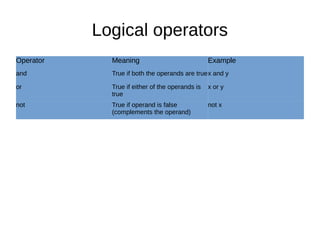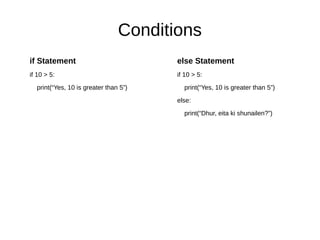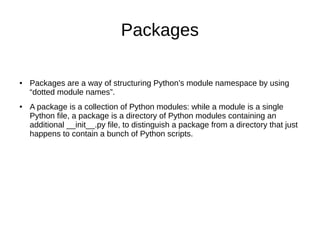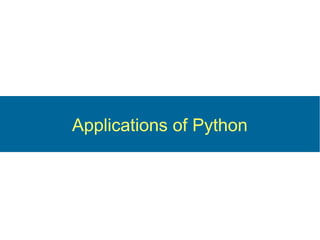Introduction to programming with python
- 1. 1 Introduction to ProgrammingIntroduction to Programming with Pythonwith Python Porimol Chandro CSE 32D World University of Bangladesh
- 2. About Me Porimol Chandro CSE 32 D World University of Bangladesh(WUB) Software Engineer, Sohoz Technology Ltd.(STL) FB : fb.com/porimol.chandro Github : github.com/porimol Email : [email protected]
- 3. Overview ● Background ● Syntax ● Data Types ● Operators ● Control Flow ● Functions ● OOP ● Modules/Packages ● Applications of Python ● Learning Resources
- 4. Background
- 6. What is Python? ● Interpreted ● High Level Programming Language ● Multi-purpose ● Object Oriented ● Dynamic Typed ● Focus on Readability and Productivity
- 7. Features ● Easy to Learn ● Easy to Read ● Cross Platform ● Everything is an Object ● Interactive Shell ● A Broad Standard Library
- 8. Who Uses Python? ● Google ● Facebook ● Microsoft ● NASA ● PBS ● ...the list goes on...
- 9. Releases ● Created in 1989 by Guido Van Rossum ● Python 1.0 released in 1994 ● Python 2.0 released in 2000 ● Python released in 2008 ● Python 3.x is the recommended version
- 10. Any Question?
- 11. Syntax
- 12. Hello World C Code: #include <stdio.h> int main() { printf("Hello World!"); return 0; } C++ Code: #include <iostream.h> main() { cout << "Hello World!"; return 0; } Python Code: print(“Hello World!”) Java Code: public class HelloWorld { public static void main(String[] args) { System.out.println("Hello World"); } }
- 13. Indentation ● Most programming language don't care about indentation ● Most humans do
- 14. Indentation C Program: #include <stdio.h> int main() { if(foo){ print(“Foo Bar”); } else{ print(“Eita kichu hoilo?”); } return 0; } Python Program: if(foo): print(“Foo Bar”) else: print(“Eita kichu hoilo?”)
- 15. Comments # This is traditional one line comments “This one is also one comment” “““ If any string not assigned to a variable, then it is said to be multi-line comments This is the example of multi-line comments ”””
- 16. Any Question?
- 17. Data Types
- 18. Data Types Python has five standard data types:- ● Numbers ● Strings ● List ● Tuple ● Dictionary
- 19. Numbers ● Integer Numbers var1 = 2017 var2 = int(“2017”) ● Floating Point Numbers var3 = 3.14159265 var4 = float(“3.14159265”)
- 20. Strings Single line str_var = “World University of Bangladesh(WUB)” Single line str_var = ‘Computer Science & Engineering’ Multi-line str_var = “““World University of Bangladesh (WUB) established under the private University Act, 1992 (amended in 1998), approved and recognized by the Ministry of Education, Government of the People's Republic of Bangladesh and the University Grants Commission (UGC) of Bangladesh is a leading university for utilitarian education.ucation.””” Multi-line str_var = ‘‘‘The University is governed by a board of trustees constituted as per private universities Act 2010 which is a non- profit making concern.’’’
- 21. List List in python known as a list of comma-separated values or items between square brackets. A list might be contain different types of items.
- 22. List Blank List var_list = [] var_list = list() Numbers roles = [1, 4, 9, 16, 25] Float cgpa = [3.85, 3.94, 3.50, 3.60] Strings departments = [“CSE”, “CE”, “EEE”, “BBA”, “ME”] Combined combined = [1, “CSE”, “CE”, 2.25, “EEE”, “BBA”, “ME”]
- 23. Tuple Tuple is another data type in python as like List but the main difference between list and tuple is that list mutable but tuple immutable.
- 24. Tuple Blank Tuple roles = () roles = tuple() Numbers roles = (1, 4, 9, 16, 25) Float cgpa = (3.85, 3.94, 3.50, 3.60) Strings departments = (“CSE”, “CE”, “EEE”, “BBA”, “ME”) Combined combined = (1, “CSE”, “CE”, 2.25, “EEE”, “BBA”, “ME”) Tuple Unpacking roles = (1, 4, 9,) a,b,c = roles
- 25. Dictionary Another useful data type built into Python is the dictionary. Dictionaries are sometimes found in other programming languages as associative memories or associative arrays.
- 26. Dictionary Blank dictionary dpt = {} dpt = dict() Set by key & get by key dpt = {1: "CSE", 2: "CE", 3: "EEE"} dpt[4] = “TE” print(dpt[1]) Key value rules A dictionary might be store any types of element but the key must be immutable. For example: marks = {"rakib" : 850, "porimol" : 200}
- 27. Any Question?
- 28. Operators
- 29. Arithmetic operators Operator Meaning Example + Add two operands x+y - Subtract right operand from the left x-y * Multiply two operands x*y / Divide left operand by the right one X/y % Modulus - remainder of the division of left operand by the right X%y // Floor division - division that results into whole number adjusted to the left in the number line X//y ** Exponent - left operand raised to the power of right x**y
- 30. Comparison operators Operator Meaning Example > Greater that - True if left operand is greater than the right x > y < Less that - True if left operand is less than the right x < y == Equal to - True if both operands are equal x == y != Not equal to - True if operands are not equal x != y >= Greater than or equal to - True if left operand is greater than or equal to the right x >= y <= Less than or equal to - True if left operand is less than or equal to the right x <= y
- 31. Logical operators Operator Meaning Example and True if both the operands are truex and y or True if either of the operands is true x or y not True if operand is false (complements the operand) not x
- 32. Bitwise operators Operator Meaning Example & Bitwise AND x& y = 0 (0000 0000) | Bitwise OR x | y = 14 (0000 1110) ~ Bitwise NOT ~x = -11 (1111 0101) ^ Bitwise XOR x ^ y = 14 (0000 1110) >> Bitwise right shift x>> 2 = 2 (0000 0010) << Bitwise left shift x<< 2 = 40 (0010 1000)
- 33. Any Question?
- 34. Control Flow
- 35. Conditions if Statement if 10 > 5: print(“Yes, 10 is greater than 5”) else Statement if 10 > 5: print(“Yes, 10 is greater than 5”) else: print(“Dhur, eita ki shunailen?”)
- 36. Loops For Loop for i in range(8) : print(i) Output 0 1 2 3 4 5 6 7 While Loop i = 1 while i < 5 : print(i) i += 1 Output 1 2 3 4 5
- 37. Any Question?
- 38. Functions
- 39. Syntax of Function Syntax: def function_name(parameters): “““docstring””” statement(s) Example: def greet(name): """This function greets to the person passed in as parameter""" print("Hello, " + name + ". Good morning!") Function Call greet(“Mr. Roy”)
- 40. Any Question?
- 41. OOP
- 42. Classes Class is a blueprint for the object. A class creates a new local namespace where all its attributes are defined. Attributes may be data or functions. A simple class defining structure: class MyNewClass: '''This is a docstring. I have created a new class''' pass
- 43. Class Example class Vehicle: # This is our first vehicle class def color(self) print(“Hello, I am color method from Vehicle class.”) print(Vehicle.color) Hello, I am color method from Vehicle class.
- 44. Objects Object is simply a collection of data (variables) and methods (functions) that act on those data. Example of an Object: obj = Vehicle()
- 45. Any Question?
- 46. Modules/Packages
- 47. Modules ● A module is a file containing Python definitions and statements. The file name is the module name with the suffix .py appended. ● A module allows you to logically organize your Python code. Grouping related code into a module makes the code easier to understand and use.
- 48. Packages ● Packages are a way of structuring Python’s module namespace by using “dotted module names”. ● A package is a collection of Python modules: while a module is a single Python file, a package is a directory of Python modules containing an additional __init__.py file, to distinguish a package from a directory that just happens to contain a bunch of Python scripts.
- 49. Any Question?
- 51. Applications ● Scientific and Numeric ● Web Application ● Mobile Application ● Cross Platform GUI ● Natural Language Processing ● Machine Learning ● Deep Learning ● Internet of Things ● ...the application goes on...
- 52. Any Question?
- 53. Learning Resources ● https://docs.python.org/3/tutorial/ ● http://python.howtocode.com.bd/ ● https://www.programiz.com/python-programming ● https://www.codecademy.com/learn/python ● https://www.tutorialspoint.com/python ● https://www.edx.org/course/subject/computer-science/python
- 54. Happy Ending!



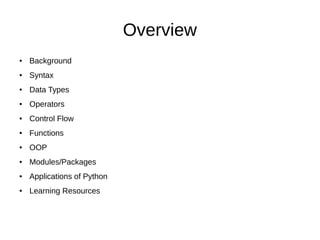


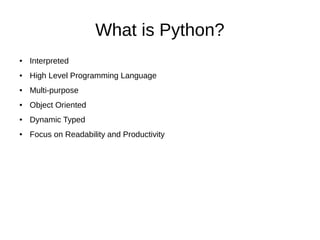

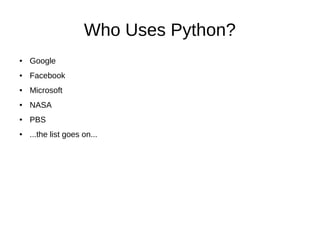



![Hello World
C Code:
#include <stdio.h>
int main()
{
printf("Hello World!");
return 0;
}
C++ Code:
#include <iostream.h>
main()
{
cout << "Hello World!";
return 0;
}
Python Code:
print(“Hello World!”)
Java Code:
public class HelloWorld {
public static void main(String[] args) {
System.out.println("Hello World");
}
}](https://image.slidesharecdn.com/introductiontoprogrammingwithpython-170423105349/85/Introduction-to-programming-with-python-12-320.jpg)

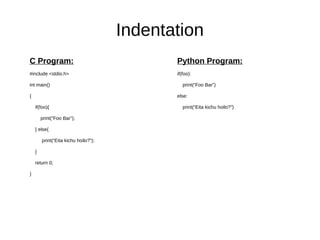
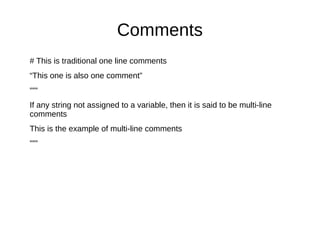





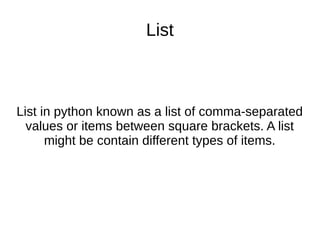
![List
Blank List
var_list = []
var_list = list()
Numbers
roles = [1, 4, 9, 16, 25]
Float
cgpa = [3.85, 3.94, 3.50, 3.60]
Strings
departments = [“CSE”, “CE”, “EEE”, “BBA”, “ME”]
Combined
combined = [1, “CSE”, “CE”, 2.25, “EEE”, “BBA”, “ME”]](https://image.slidesharecdn.com/introductiontoprogrammingwithpython-170423105349/85/Introduction-to-programming-with-python-22-320.jpg)

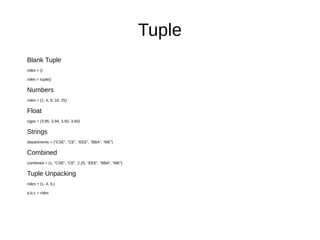

![Dictionary
Blank dictionary
dpt = {}
dpt = dict()
Set by key & get by key
dpt = {1: "CSE", 2: "CE", 3: "EEE"}
dpt[4] = “TE”
print(dpt[1])
Key value rules
A dictionary might be store any types of element but the key must be immutable.
For example:
marks = {"rakib" : 850, "porimol" : 200}](https://image.slidesharecdn.com/introductiontoprogrammingwithpython-170423105349/85/Introduction-to-programming-with-python-26-320.jpg)




